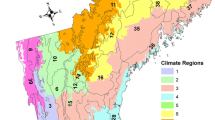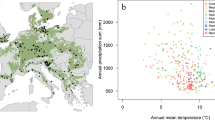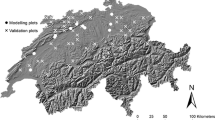Abstract
Projections of vegetation distribution that incorporate the transient responses of vegetation to climate change are likely to be more efficacious than those that assume an equilibrium between climate and vegetation. We examine the non-equilibrium dynamics of a temperate forest region under historic and projected future climate change using the dynamic ecosystem model LPJ-GUESS. We parameterized LPJ-GUESS for the New England region of the United Sates utilizing eight forest cover types that comprise the regionally dominant species. We developed a set of climate data at a monthly-step and a 30-arc second spatial resolution to run the model. These datasets consist of past climate observations for the period 1901–2006 and three general circulation model projections for the period 2007–2099. Our baseline (1971–2000) simulation reproduces the distribution of forest types in our study region as compared to the National Land Cover Data 2001 (Kappa statistic = 0.54). Under historic and nine future climate change scenarios, maple-beech-basswood, oaks and aspen-birch were modeled to move upslope at an estimated rate of 0.2, 0.3 and 0.5 m yr−1 from 1901 to 2006, and continued this trend at an accelerated rate of around 0.5, 0.9 and 1.7 m yr−1 from 2007 to 2099. Spruce-fir and white pine-cedar were modeled to contract to mountain ranges and cooler regions of our study region under projected future climate change scenarios. By the end of the 21st century, 60% of New England is projected to be dominated by oaks relative to 21% at the beginning of the 21st century, while northern New England is modeled to be dominated by aspen-birch. In mid and central New England, maple-beech-basswood, yellow birch-elm and hickories co-occur and form novel species associations. In addition to warming-induced northward and upslope shifts, climate change causes more complex changes in our simulations, such as reversed conversions between forest types that currently share similar bioclimatic ranges. These results underline the importance of considering community interactions and transient dynamics in modeling studies of climate change impacts on forest ecosystems.






Similar content being viewed by others
References
Ainsworth EA, Long SP (2005) What have we learned from 15 years of free-air CO2 enrichment (FACE)? A meta-analytic review of the responses of photosynthesis, canopy properties and plant production to rising CO2. New Phytol 165:351–372
Bachelet D, Neilson RP, Lenihan JM, Drapek RJ (2001) Climate change effects on vegetation distribution and carbon budget in the United States. Ecosystems 4:164–85
Beckage B, Osborne B, Gavin DG, Pucko C, Siccama T, Perkins T (2008) A rapid upward shift of a forest ecotone during 40 years of warming in the Green Mountains of Vermont. Proc Natl Acad Sci 105:4197–4202
Beckage B, Gross L, Kauffman S (2011) The limits to prediction in ecological systems. Ecosphere. In press.
Cleveland WS (1979) Robust locally weighted regression and smoothing scatterplots. J Am Stat Assoc 74:829–836
Cohen J (1960) A coefficient of agreement for nominal scales. Educ Psychol Meas 20:37–46
Cole CT, Anderson JE, Lindroth RL, Waller DM (2010) Rising concentrations of atmospheric CO2 have increased growth in natural stands of quaking aspen. Glob Change Biol 10:2186–2197
Daly C, Taylor GH, Gibson WP, Parzybok TW, Johnson GL, Pasteris P (2000) High-quality spatial climate data sets for the United States and beyond. Trans Am Soc Agric Eng 43:1957–1962
Daly C, Gibson WP, Taylor GH, Gibson WP, Parzybok TW, Johnson GL, Pasteris P (2002) A knowledge-based approach to the statistical mapping of climate. Climate Res 22:99–113
Davis MB (1989) Lags in vegetation response to greenhouse warming. Climatic Change 15:75–82
Davis MB, Shaw RG (2001) Range shifts and adaptive responses to quaternary climate change. Science 292:673–679
Evans AM, Perschel R (2009) A review of forestry mitigation and adaptation strategies in the Northeast US. Climatic Change 96:167–183
FAO (1991) The digitized soil map of the world (release 1.0). Vol. 67/1, Food and Agriculture Organization of the United Nations.
Farnsworth EJ, Ogurcak DE (2006) Biogeography and decline of rare plants in New England: historical evidence and contemporary monitoring. Ecol Appl 16:1327–1337
Farr TG, Kobrick M (2000) Shuttle Radar Topography Mission produces a wealth of data. Am Geophys Union Eos 81:583–585
Foster DR, Motzkin G, Slater B (1998) Land-use history as long-term broad-scale disturbance: regional forest dynamics in central New England. Ecosystems 1:96–119
Foster DR, Clayden S, Orwig DA, Hall B, Barry S (2002) Oak, chestnut and fire: climatic and cultural controls of long-term forest dynamics in New England, USA. J Biogeogr 29:1359–1379
Foster DR, Oswald WW, Faison EK, Doughty ED, Hansen BCS (2006) A climatic driver for abrupt mid-Holocene vegetation dynamics and the hemlock decline in New England. Ecology 87:2959–2966
Fuller TL, Foster DR, McLachlan JS, Drake N (1998) Impact of human activity on regional forest composition and dynamics in central New England. Ecosystems 1:76–95
Gordon C, Cooper C, Senior CA, Banks HT, Gregory JM, Johns TC, Mitchell JFB, Wood RA (2000) The simulation of SST, sea ice extents and ocean heat transports in a version of the Hadley Centre coupled model without flux adjustments. Clim Dynam 16:147–168
Hagen-Zanker A, Straatman B, Uljee I (2005) Further developments of a fuzzy set map comparison approach. Int J Geogr Inf Sci 19:769–785
Hall B, Motzkin G, Foster DR, Syfert M, Burk J (2002) Three hundred years of forest and land-use change in Massachusetts, USA. J Biogeogr 29:1319–1335
Hickler T, Smith B, Sykes MT, Davis MB, Sugita S, Walker K (2004) Using a generalized vegetation model to simulate vegetation dynamics in northeastern USA. Ecology 85:519–530
Hickler T, Smith B, Prentice IC, Mjofors K, Miller P, Arneth A, Sykes MT (2008) CO2 fertilization in temperate FACE experiments not representative of boreal and tropical forests. Glob Change Biol 14:1531–1542
Hooker TD, Compton JE (2003) Forest ecosystem carbon and nitrogen accumulation during the first century after agricultural abandonment. Ecol App 13:299–313
IPCC (2007) Summary for policymakers. In: Parry ML, Canziani OF, Palutikof JP, van der Linden PJ, Hanson CE (eds) Climate Change 2007: Impacts, adaptation and vulnerability. Contribution of Working Group II to the Fourth Assessment Report of the Intergovernmental Panel on Climate Change. Cambridge University Press, Cambridge, pp 7–22
Iverson LR, Prasad AM (2001) Potential changes in tree species richness and forest community types following climate change. Ecosystems 4:186–199
Jay RM, Adam M, Ronald PN, Michael G (2002) Estimated migration rates under scenarios of global climate change. J Biogeogr 29:835–849
Jungclaus JH, Botzet M, Haak H, Keenlyside N, Luo JJ, Latif M, Marotzke J, Mikolajewicz U, Roeckner E (2005) Ocean circulation and tropical variability in the AOGCM ECHAM5/MPI-OM. J Climate 19:3952–3972
Kelly PM, White JM (1993) Preprocessing remotely sensed data for efficient analysis and classification, applications of artificial intelligence 1993: knowledge-based systems in aerospace and industry. Proc SPIE 1993:24–30
Kim SJ, Flato GM, Boer GJ, Boer GJ (2002) A coupled climate model simulation of the Last Glacial Maximum, Part 1: transient multi-decadal response. Clim Dynam 19:515–537
Kim SJ, Flato GM, Boer GJ (2003) A coupled climate model simulation of the Last Glacial Maximum, Part 2: approach to equilibrium. Clim Dynam 20:635–661
Koca D, Smith B, Sykes MT (2006) Modelling regional climate change effects on potential natural ecosystems in Sweden. Climatic Change 78:381–406
Landis JR, Koch GG (1977) Application of hierarchical Kappa-type statistics in assessment of majority agreement among multiple observers. Biometrics 33:363–374
McKenny DW, Pedlar JH, Lawrence K, Campbell K, Hutchinson MF (2007) Potential impacts of climate change on the distribution of North American trees. BioScience 57:939–948
McLachlan JS, Clark JS, Manos PS (2005) Molecular indicators of tree migration capacity under rapid climate change. Ecology 86:2088–2098
Mitchell TD, Jones PD (2005) An improved method of constructing a database of monthly climate observations and associated high-resolution grids. Int J Climatol 25:693–712
Monserud RA, Leemans R (1992) Comparing global vegetation maps with the Kappa statistic. Ecol Model 62:275–293
Morales P, Sykes MT, Prentice IC et al (2005) Comparing and evaluating process-based ecosystem model predictions of carbon and water fluxes in major European forest biomes. Glob Change Biol 11:2211–2233
Oswald WW, Foster DR, Dought ED, Faison EK (2009) A record of Lateglacial and early Holocene environmental and ecological change from southwestern Connecticut, USA. J Quaternary Sci 24:553–556
Parmesan C, Yohe G (2003) A globally coherent fingerprint of climate change impacts across natural systems. Nature 421:37–42
Parshall T, Foster DR, Faison E, Macdonald D, Hansen BCS (2003) Long-term history of vegetation and fire in pitch pine-oak forests on Cape Cod, Massachusetts. Ecology 84:736–748
Pope V, Gallani ML, Rowntree PR, Stratton RA (2000) The impact of new physical parameterizations in the Hadley Centre climate model: HadAM3. Clim Dynam 16:123–146
Prentice IC, Solomon AM (1990) Vegetation models and global change. In: Bradley RS (ed) Global changes of the past. UCAR/Office for Interdisciplinary Earth Studies, Boulder, pp 365–83
Rosen PA, Hensley S, Joughin IR, Li FK, Madsen SN, Rodriguez E, Goldstein RM (2000) Synthetic aperture radar interferometry. Proc IEEE 88:333–382
Schlesinger ME, Malyshev S (2001) Changes in near-surface temperature and sea level for the Post-SRES CO2-stabilization scenarios. Integr Assess 2:95–110
Shuman B, Newby P, Huang Y, Thompson WEBB III (2004) Evidence for the close climatic control of New England vegetation history. Ecology 85:1297–1310
Sitch S, Smith B, Prentice IC et al (2003) Evaluation of ecosystem dynamics, plant geography and terrestrial carbon cycling in the LPJ Dynamic Global Vegetation Model. Glob Change Biol 9:161–185
Smith B, Prentice IC, Sykes MT (2001) Representation of vegetation dynamics in the modeling of terrestrial ecosystems: comparing two contrasting approaches within European climate space. Global Ecol Biogeo 10:621–637
Tang G, Bartlein PJ (2008) Simulating the climatic effects on vegetation: approaches, issues and challenges. Prog Phys Geog 32:543–556
Tang G, Beckage B (2010) Projecting the distribution of forests in New England in response to climate change. Divers Distrib 16:144–158
Tang G, Shafer SL, Bartlein PJ, Holman (2009) Effects of experimental protocol on global vegetation model accuracy: A comparison of simulated and observed vegetation patterns for Asia. Ecol Model 220:1481–1491
Tang G, Beckage B, Smith B, Miller PA (2010) Estimating potential forest NPP, biomass and their climatic sensitivity in New England using a regional dynamic ecosystem model. Ecosphere 1:1–20 (Article 18)
Vogelmann JE, Sohl T, Campbell PV, Shaw DM (1998a) Regional land cover characterization using landsat thematic mapper data and ancillary data sources. Environ Monit Assess 51:415–428
Vogelmann JE, Sohl T, Howard SM (1998b) Regional characterization of land cover using multiple sources of data. Photogramm Eng Remote Sens 64:45–47
Withington JM, Reich PB, Oleksyn J, Eissenstat DM (2006) Comparisons of structure and life span in roots and leaves among temperate trees. Ecol Monogr 76:381–397
Woodward FI, Beerling DJ (1997) The dynamics of vegetation change: health warnings for equilibrium ‘dodo’ models. Global Ecol Biogeogr 6:413–418
Woodward FI, Lomas MR (2004) Vegetation dynamics—simulating responses to climatic change. Biol Rev 79:643–70
Wramneby A, Smith B, Zaehle S, Sykes MT (2008) Parameter uncertainties in the modeling of vegetation dynamics—Effects of on tree community structure and ecosystem functioning in European forest biomes. Ecol Model 216:277–290
Acknowledgements
This study was supported by the US Department of Energy’s Office of Science (BER) through the Northeastern Regional Center of the National Institute for Climatic Change Research. We appreciate the Vermont Advanced Computing Center for providing high-performance clusters for our model simulations. We thank Robert Devins and Chris Ellingwood for their technical help in this study.
Author information
Authors and Affiliations
Corresponding author
Electronic supplementary material
Below is the link to the electronic supplementary material.
ESM 1
(DOC 227 kb)
Rights and permissions
About this article
Cite this article
Tang, G., Beckage, B. & Smith, B. The potential transient dynamics of forests in New England under historical and projected future climate change. Climatic Change 114, 357–377 (2012). https://doi.org/10.1007/s10584-012-0404-x
Received:
Accepted:
Published:
Issue Date:
DOI: https://doi.org/10.1007/s10584-012-0404-x




